Book reviews, Winter 2012/13
A WALK THROUGH NORWELL
DVD published by Norwell Parish Heritage Group, 2012. Cost £4.00 plus 75p p&p. Contact emjones,norwell@btinternet.com or 01636-636-365.
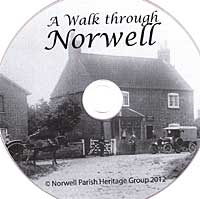
Norwell Parish Heritage Group is a very active group, leading the way for such groups and local history societies in the way they publish the results of their research work. The Newsletter has reviewed several of their publications and, without fail, the works have been very highly praised, both for content and presentation.
Whilst this is not the first DVD reviewed in these columns, it is the first of its kind. The viewer is taken on a virtual walk through the village, accompanied by appropriate sounds. The images are all early 20th century ones, mainly from postcards published at the time and which are animated so that the feeling of an actual walk is created. The animations turn left, right and zoom in and out, as though the viewer is actually looking at the village scenes whilst walking along the streets.
Norwell is lucky, for a small village, that such interesting photographs were taken at the beginning of the 20th century and that they have been preserved and collected.
The Norwell Parish History Group has produced a fascinating DVD which shows, once again, that they lead the way in creative presentation of their village’s history. Buy this DVD, it is cheap enough, and use it to stimulate your own way of presenting old images of village and town scenes as well as enjoying it for what it basically is, a stroll back in time through one of the county’s very interesting villages.
HF
KEYWORTH PIONEERS in the CANADIAN PRAIRIES: A story of courage, fortitude and determination.
Margaret Wright, Keyworth & District Local History Society, 2012, Price £2.50. Contact the editor.
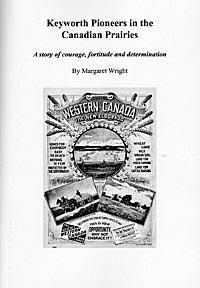
This is the latest booklet published by KDLHS in their Occasional Papers series. 56 pages in A5 format and profusely illustrated this booklet tells the story of some Keyworth families who emigrated to Canada at the turn of the 20th Century. The author has had much contact with modern members of the families and has benefitted from their memories and photographs of their forebears, indeed, this story could not have been told without their help.
In 1896 the Canadian government had a publicity drive to encourage settlement in the Saskatchewan area of the Canadian prairies by way of a poster and associated publicity. The offer was a grant of 160 acres of land for a cost of $10 and the conditions were that they had to live on the land for at least six months for three years and in that time to erect a house worth $300 and cultivate at least 30 acres of the land.
This sounds simple enough but the pioneers had to build their houses of timber by themselves and to learn how to cultivate the land bearing in mind that none of them were from a farming background. That they succeeded and became successful in their new land is a story well worth the telling – they even named a settlement, Keyworth, after their home village here in Notts. This sort of publication is ideal for Local History Societies to tackle, not too difficult to prepare for publication or too expensive to produce. The very modest selling price reflects the fact that they simply need to cover costs and not turn a grand profit and so makes them affordable for virtually anyone. Without them, much of the history of villages and peoples would remain unknown and our knowledge and understanding of the relatively recent past less rich. These booklets produced by various local history societies deserve to be bought by people who are not direct residents of the places concerned or direct family members because, although stories of micro-events, they do contribute greatly to a wider understanding of the place of ordinary folk in the history of our villages, towns, cities, counties and country.
DESCENDANTS OF SAMUEL DISNEY OF RADCLIFFE-ON-TRENT Volume 1 Introduction and Part 1 Keyworth and Nottinghamshire.
Dr. Helen M. Coan. Self-published in 2012. Cost £30.00 from the author (contact helencoan@btinternet.com - or through the Newsletter editor ISBN 978-0-9556733-7-5

Dr. Helen Coan lives in Cheshire. She has been researching the Disney name since 1966, is registered with the Guild of One Name Studies and is the project leader for the Disney DNA study. In other words she is the acknowledged expert on the Disney family name. Her father was Harold Vernon Disney who started the family history study and who encouraged Helen to continue it. This book is volume 1, volumes 2 and 3 will deal with the Disney families who moved into Derbyshire and into Quorn, Leicestershire respectively.
The book is A4 in size, has soft covers and 234 pages with many illustrations and diagrams. It is very nicely printed on glossy paper.
I will get the niggles out of the way first: these are mainly proof reading problems and some may, perhaps, be due to an unfamiliarity with Nottinghamshire, for example there are several references to Pierrepoint, both the family and the hamlet, which should be correctly spelled as Pierrepont – although later in the book it is correctly spelled. Early in the book Selby Lane, Keyworth is called Selby Road although all subsequent references are correct. The wedding photograph of Annie Rebecca Disney and Arthur Henry Wilson shows him in army uniform with a wound stripe of his left sleeve (the right arm cannot be seen) but the text refers to the stripe on the right sleeve. Towards the end of the book a few names appear underlined which is not consistent with the rest of the book. There are one or two other instances which I will not dwell on. All these can be easily remedied in a future print run if required.
I must emphasise that these are little niggles and in no way detract from the value of what is an extremely well written and meticulously researched book. Helen has used all the sources and resources available to family historians and the detail she has used is the result of hours and hours of very patient work as well as much travel to visit the places and archive centres involved. It requires a very dedicated person to undertake such detail and to lead the world wide study of a family name in the way Helen continues to do. I am certain that her father would be very proud indeed of her work and the quality of this book were he able to see it.
Writing the story of a family is not easy, inevitably there is much repetition of words and a continuous listing of names and events of great similarity. The way this book is structured helps tremendously in following the various strands of the family and the very many trees relating to the differing strands of the family ensure that the stories and linkages can be easily followed.
It would, however, be wrong to think that the book is simply a list of names and events. It is much, much more than that; these are stories of the lives of the people concerned, many in good detail and this allows an understanding of the life of the people involved, of the communities and the places where they lived – this is as much a social history as a family history book.
The Disney name has been very strong in the history of Keyworth with its many family members taking full part in village life from the religious in all three churches to sport in the football and cricket clubs. The Disneys are interwoven with the story of the folk of the village. Sadly there are few of the family, direct or indirect, now still living there. The book provides insight into the houses, rented and those built by family members, and the businesses in which they were involved. Helen has done a lot of research into the village itself and there are new facts produced which add to the village’s history. There are, inevitably, some contentious statements which would benefit from source explanation – for example, it is said that most of the girls in the village at one time worked in the hosiery factories in Nottingham in the periods after the railway came to Plumtree, I would be most interested in knowing the source for this comment.
The Disney name spread beyond Keyworth into several other villages and town of Nottinghamshire, indeed beyond the UK and Helen expertly follows all the strands in a well written and easily followed manner. It is an honest book, the author is not afraid to say when information has not yet been found or to say when family members disgraced themselves and appeared in court. A family’s story would be incomplete without these details yet many family historians seem shocked to discover such facts; certainly not Helen Coan.
This book is a must for the bookshelves of anyone with a connection to the Disneys but also to anyone who has an interest in Nottinghamshire itself. It is also a model for any family historian intending to write up the story of their family. It is well worth the price and is a book that will not only adorn the bookshelf but which will be frequently taken down and referred to. Buy it, you will not be disappointed.
HF
TIME GENTLEMEN PLEASE: Village Public Houses in South Nottinghamshire in days gone
Bernard Heathcote, Nottinghamshire County Council, 2012. ISBN: 978 0 902751 73 6
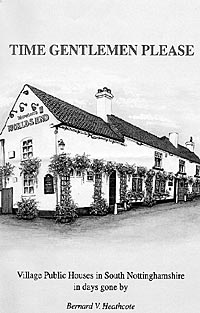
This book is a comprehensive survey of the history of pubs in the south of the county, specifically within the Hundred of South Nottinghamshire.
This is a ‘must buy’ for local historians and an inspiration to groups looking for a project! Its completion was delayed by a problem familiar to many researchers because much of the detail came from scanning microfilm of local newspapers in the Nottingham Local Studies Library. These showed how much could be gleaned from Coroner’s Inquests since the local pub often offered the best venue. The reports themselves provided so much fascinating local detail that the author was side-tracked into producing another book first – Viewing the Lifeless Body, also in this series and published by Notts County Council in 2005.
For each of the eleven villages included in the survey there is a comprehensive history of each pub and beer house, illustrated with photographs and drawings and with a list of the licencees over the years. Each village entry is also interspersed with fascinating extracts from the inquests held on the premises and these provide further nuggets of local history.
This is a welcome addition to the excellently produced series of monographs on local history published by the County Council, available from most public libraries , the Archive office or by post from Nottinghamshire County Council, Libraries, Archives and Information, 4th Floor, County Hall, West Bridgford, Nottingham, NG2 7QP. Cost £7.50 or, by post, £10.50.
David Bagley
HOLME PIERREPONT: Its history from the earliest times to the 1801 census
Beryl Cobbing, Ashbracken and Radcliffe-on-Trent Local History Society, 2012. ISBN 978-1-872356-13-6
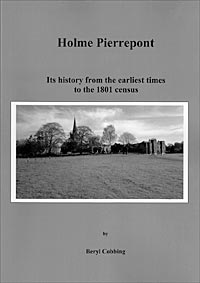
Ashbracken is a small personal publisher based in Radcliffe-on-Trent which publishes the books of the Radcliffe-on-Trent Local History Society.
This latest book is A4 format with soft covers, 288 pages with excellent pages of sources (called Notes and References, a useful glossary of terms found in the book and a comprehensive index which is always an excellent feature to include in local history books. It is very well illustrated with colour pictures, mono illustrations, line drawings, maps and plans, all of which adds up to a very nicely presented publication, as we have come to expect from Radcliffe-on-Trent LHS.
One aspect of the book that I am critical of, and I accept that I have long had a bee-in-my-bonnet about it, is the way of spelling the region’s name. The book uses ‘east Midlands’ whereas I firmly believe the region should be expressed with two capitals as East Midlands. I recall several years ago, before I retired from paid work, that the Chamber of Commerce asked local businesses to put ‘East Midlands’ as part of their addresses and, of course, there was the publicity a few years ago about the name of the airport which, eventually reverted to East Midlands Airport. The use of small letters as ‘east midlands’ seems to be a peculiarity of historical writings as, in everything else I read it is used, correctly I argue, as ‘East Midlands’. Having got that item off my chest I return to the substance of this book. It is written in a style which is easy to read whilst fully conveying the detail of the extensive research which has gone into the work. The context of each period is fully explained and the first two chapters set the scene very well indeed.
This very well researched book takes us through time up to its 1801 cut off date in great detail with information gleaned from all the sources available to local historians. We are given insights into the people of the parish, both great and less great through wills, parish records and farm records. Obviously the Pierrepont family figure highly in the book but also the people of the parish, richer and poorer receive full consideration where information is available.
The parish constituted the townships of Holme, Bassingfield, and parts of Lamcote, Adbolton and Gamston, the former shared with Radcliffe-on-Trent and the latter two with West Bridgford.
A complete picture of the parish and its people is provided and, as well as being a history of Holme Pierrepont there is much information herein which will be of value to others researching aspects of Nottinghamshire and the East Midlands because comparisons and contrasts can be made with Holme Pierrepont using the information presented in the book.
This is a high quality production, very well researched and it is sold at an attractive and affordable price. Details from Marion Caunt on 0115-933-2685, email: radcliffeontrenthistorysociety@gmail.com or Ashbracken, 14 Cropwell Road, Racliffe-on-Trent, NG12 2FS, email: neal@ashbracken.com.
HF
MADE IN NOTTINGHAM
Peter Mortimer, Five Leaves Publications, 2012. ISBN: 978-1907-869-52-5
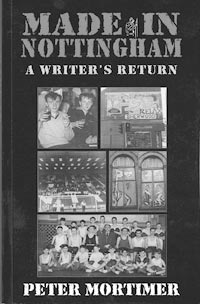
Peter Mortimer, the author of this book, was born in Danethorpe Way, Sherwood, Nottingham, 66 years ago. He moved away from the city in 1963 at the age of 19 and eventually settled in Newcastle-upon-Tyne where he abandoned his career in the newspaper industry to become a full time writer.
This book is the story of a month of his life when he decided to revisit Nottingham, in particular the Sherwood district he had known as a boy until the age of 19.
At first sight, this book has the appearances of a straight forward journey of reliving old memories, but quite early on it becomes obvious that there is far more to it than that. Indeed, the book takes on a multiplicity of aims and is, at first, a little confusing. Instead of a memoir of his boyhood, it soon becomes apparent that the estate the author knows from his youth sparks other memories and incidents, takes on at times the mantle of a documentary and at others, a social documentary not anticipated at the beginning.
Many of us experience the temptation of ‘going back’ and some actually take that step. Mortimer reveals that his experience was less than satisfactory in a number of ways, uppermost, it seems, is the feeling of not belonging any more. The longing to revisit the house in which he lived and the frustrations he suffered as a result of his failure to achieve his near obsession is a poignant reminder to all of us of the fact that time never stands still and longings for yesteryear are not often productive.
There are some inaccuracies in the text. These have been largely communicated to the author by one who knows the area and the personalities better than this reviewer. Additionally, there are sections of the book that detract from the enjoyment to some degree. For example, it is easy to imagine how some events or sights or conversations trigger other memories, but in the chapters containing reminiscences concerning Nottingham authors, the detailed descriptions appear to be irrelevant. A further distraction is the small postscripts that are added to most of the chapters. These seem to have been inserted for no apparent reason and add little to the interest of the book. Also, one could have hoped for photographs of somewhat better quality. One useful addition would have been a map that showed both the district of Sherwood and its relationship with the centre of the city.
These drawbacks apart, there are in this book, enough reminiscences to provide a spark to any reader, whatever their background or wherever he or she calls home, to recall similar events or sights of their own. Many of the memories of earlier Sherwood are easily transferred to one’s own upbringing and surroundings and so many descriptions fit other cities and towns of the era that one can be transported to days gone by and this is very stimulating.
On the whole, reading the book is quite pleasing and will bring back memories of one’s own youth, especially to those who knew the Nottingham of the 50’s and 60’s and, in particular, the area surrounding the district of Sherwood. It does, however, contain the warning that ‘going back’ may not provide the desired experience.
Alan Butler.
LOWDHAM, CAYTHORPE and GUNTHORPE THROUGH TIME
Lowdham Local History Society, 96 pages. Amberley Publishing Co. ISBN 978 1 4456 0836. Costs £14.99. No index.
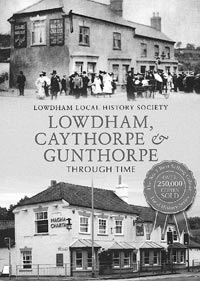
This is another volume produced by the Lowdham Local History Society, which consists primarily of photographs showing scenes of the parishes – ‘Through Time’. The older photographs are in sepia together with modern photographs in colour.
In some cases the changes are very dramatic indeed whilst others show only minor alterations. All are thought provoking as the majority of these changes and developments have only taken place in the last 100 years.
As a study in the urbanization of a village, these well chosen photographs give much food for thought. This is a book which will take the local reader down memory lane and might well illuminate those questions: ‘Do you remember when ...?’
A book with this pedigree is well worth considering.
Jim and Pauline Chettle.